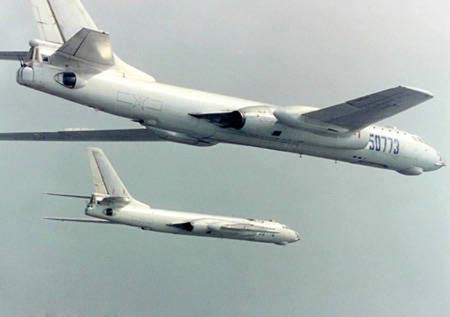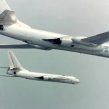
China-Japan Relations Worsen as Chinese Naval Aviation Flies Through “First Island Chain”
Publication: China Brief Volume: 13 Issue: 22
By:

China’s relationship with Japan took a turn for the worse this past week, with a number of incidents and statements increasing tensions over the disputed Diaoyu/Senkaku islands. On October 27th, a formation of H-6 bombers and Y-8 surveillance aircraft passed the disputed area on their way through the Miyako Strait to the Pacific Ocean (Kyodo News, October 27). Similar flights followed for the next two days. This was the largest-ever formation of Chinese military aircraft to transit the area, and the first to be repeated on successive days.
Over the past two months, flights by Chinese surveillance aircraft, drones and bombers through the Miyako Strait, a gap in Japanese airspace and territorial waters in the Ryukyu Island Chain, have prompted frequent scrambles of Japanese Air Self-Defense Force (JASDF) jets. Though these sorts of flights (and interceptions) have happened regularly since September, the series of flights ending on October 29th was noteworthy in the number of aircraft, and duration (three consecutive days).
A translation of a question and answer session with the Japanese Minister of Defense posted on the MOD’s website quoted him as saying “I interpret this behavior as an example of China’s aggressive expansion of its active range that includes the ocean” (Japanese Ministry of Defense, October 29). Previously, unaccompanied Chinese bombers had only transited this area on two occasions, in late July and early September (Asahi Shimbun, September 9). Additionally, China’s Coast Guard frequently patrols the area close to the Diaoyu/Senkaku Islands (Kyodo News, October 28).
This follows on strident policy statements from the Abe administration in response to China’s use of drones to survey disputed areas. It has been widely reported that a plan drawn up by Mr. Abe would have Japanese defense forces shoot down drones that violated Japanese airspace. In response, Chinese defense ministry spokesperson Geng Yansheng responded that it would view such action as “a severe provocation” and tantamount to a declaration of war (Xinhua, October 27; Global Times, October 27). China continues to insist that the territory in dispute is its own, and that the Coast Guard vessels and military aircraft are merely carrying out police duties.
While tensions have been rising with Japan, China has been pursuing a campaign to bolster “peripheral diplomacy,” strengthening ties with other neighboring countries, and threatening Japan with regional isolation (for more this effort, see “ Diplomacy Work Forum: Xi Steps Up Efforts to Shape a China-Centered Regional Order,” in this issue).
The United States will also soon be flying drones from Japan, including the long-range “Global Hawk,” in addition to conventional maritime surveillance aircraft (WantChinaTimes, October 4). Beyond tensions over the Diaoyu/Senkaku Islands, these surveillance aircraft, manned and unmanned, are being tasked with monitoring an area of great strategic significance.
Although China’s bombers are passing through international airspace, their route is an important one to Chinese military strategy. The Miyako Strait is a key international bottleneck for China, being its primary exit from eastern China to the Pacific Ocean, and the only sea or air route that does require passing through Japanese or disputed territory. In recent years China has sent more and more ships through this area to conduct naval exercises in international waters. The Strait, which goes between two islands of the Ryukyu Chain, has Okinawa on one side and Miyako Island on the other, both with large populations.
The strait is thus of huge significance to the Chinese navy and particularly its goal of exerting influence past the so-called “First Island Chain,” which includes Okinawa and the Ryukyus. The ability to project power beyond this area is key to China being able to overcome what some have labeled the “C-shaped Containment strategy”—a notional arc of nations allied with the United States stretching from northern Japan down through the Philippines and beyond (See “C-Shaped Containment” [C Xing Bao Wei], by the military commentator and PLA Air Force Senior Colonel Dai Xu).
The Miyako Strait (as well as both Okinawa and Mikayo Island) is only a little over 500 miles to the southeast of Shanghai. It is even closer to Ningbo, the home of China’s East Sea Fleet. Using available estimates of the H-6’s range, a bomber flying from Benniu Airbase (PLA Naval Aviation) could make a round trip through the Strait more than half-way to the Second Island Chain, which includes U.S. territories Guam and the Marinas Islands, using only accepted international airspace. Flying close to the Diaoyu/Senkakus decreases this figure somewhat, making these flights strategically important as well as symbolic. As China is showing the flag to Japan, exercising its rights to transit international airspace, it is also conspicuously demonstrating force projection capabilities.
Its audience likely includes the United States, with its second island chain presence, as well as Japan. Perhaps in response, the United States has recently committed to building a second airbase on Saipan to complement Anderson Airbase on Guam (WantChina Times, September 30).
At the same time as it has expanded patrols of disputed areas, China has been showcasing its nuclear submarine force. Long regarded as a non-threat due to technical issues and small size, China, in a series of articles and programs on official television programs, has revealed details about its submarine force to the public (People’s Daily, October 28). According to an article in Seeking Truth, the revelations are meant to reassure the public of the efficacy of China’s nuclear deterrent, and also to signal to other states that China has a reliable nuclear deterrent with full second strike ability. Such a signal could also be directed at Japan and the United States, with the goal of minimizing their response to Chinese assertiveness.
China has thus far been able to avoid escalation after a series of incidents, from painting Japanese ships with fire-control radar to frequent patrols near disputed areas with its Coast Guard. Whether Japan will continue to exercise restraint remains to be seen.





